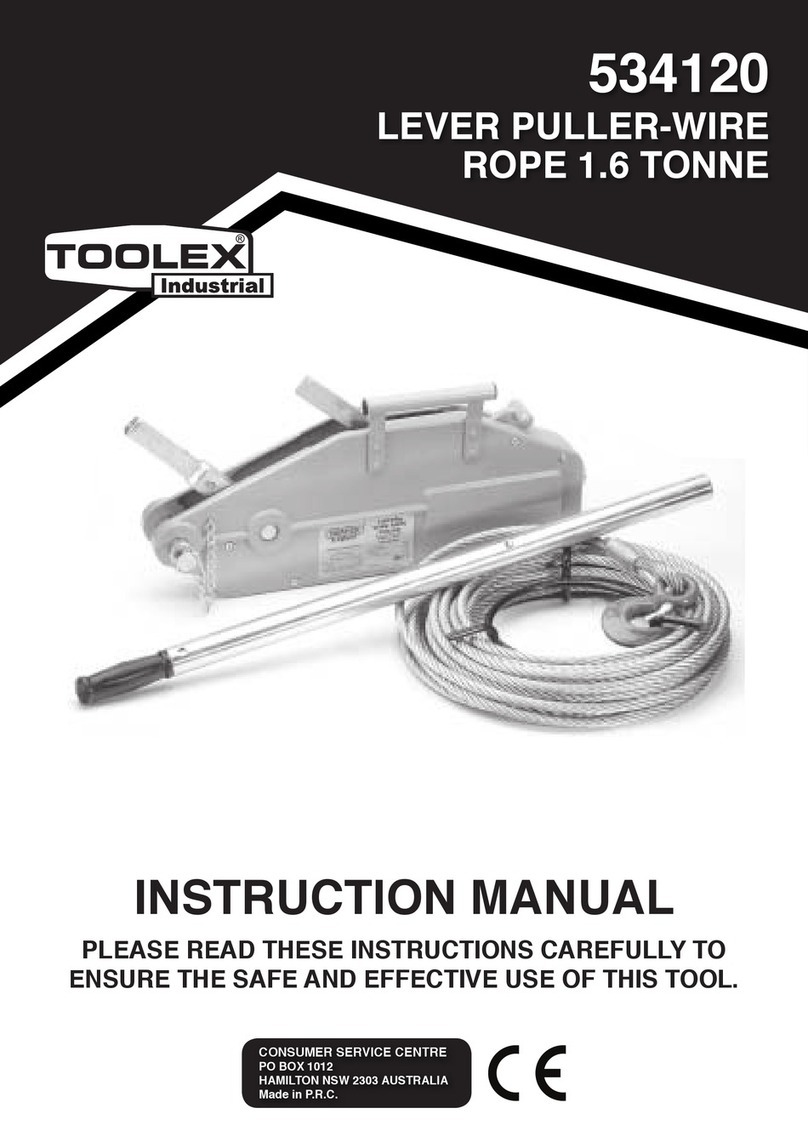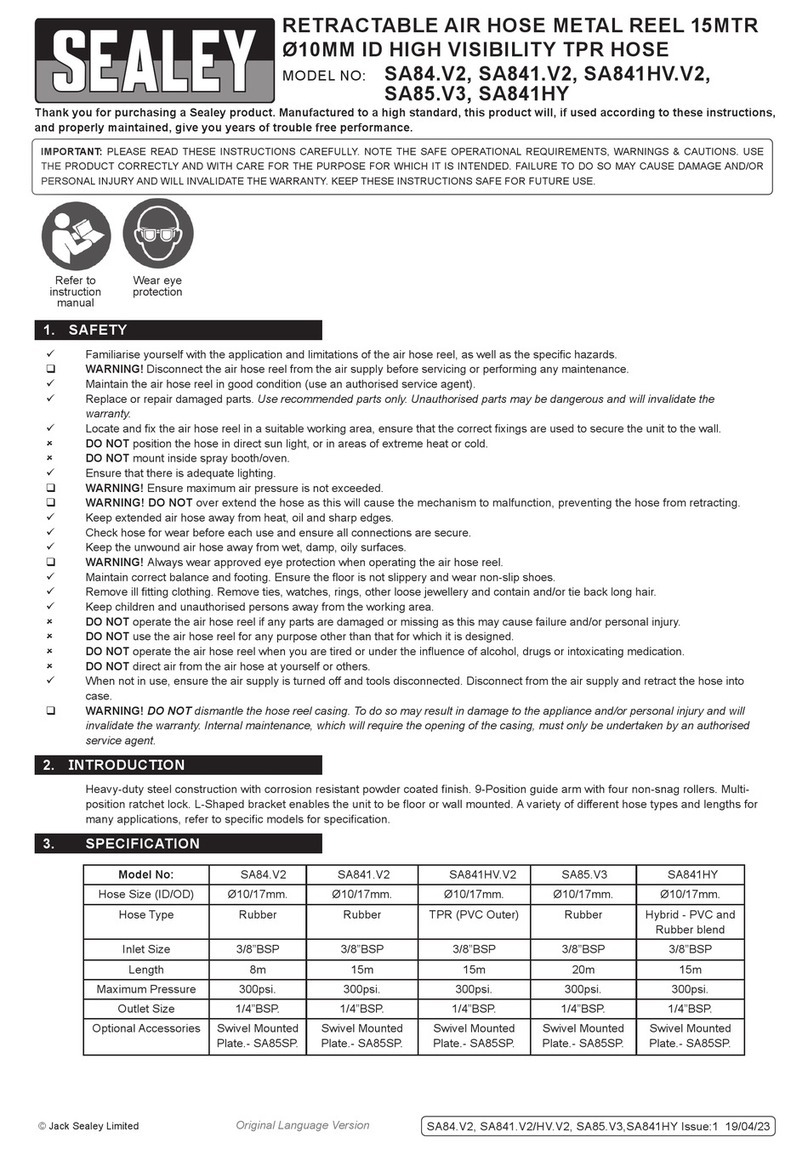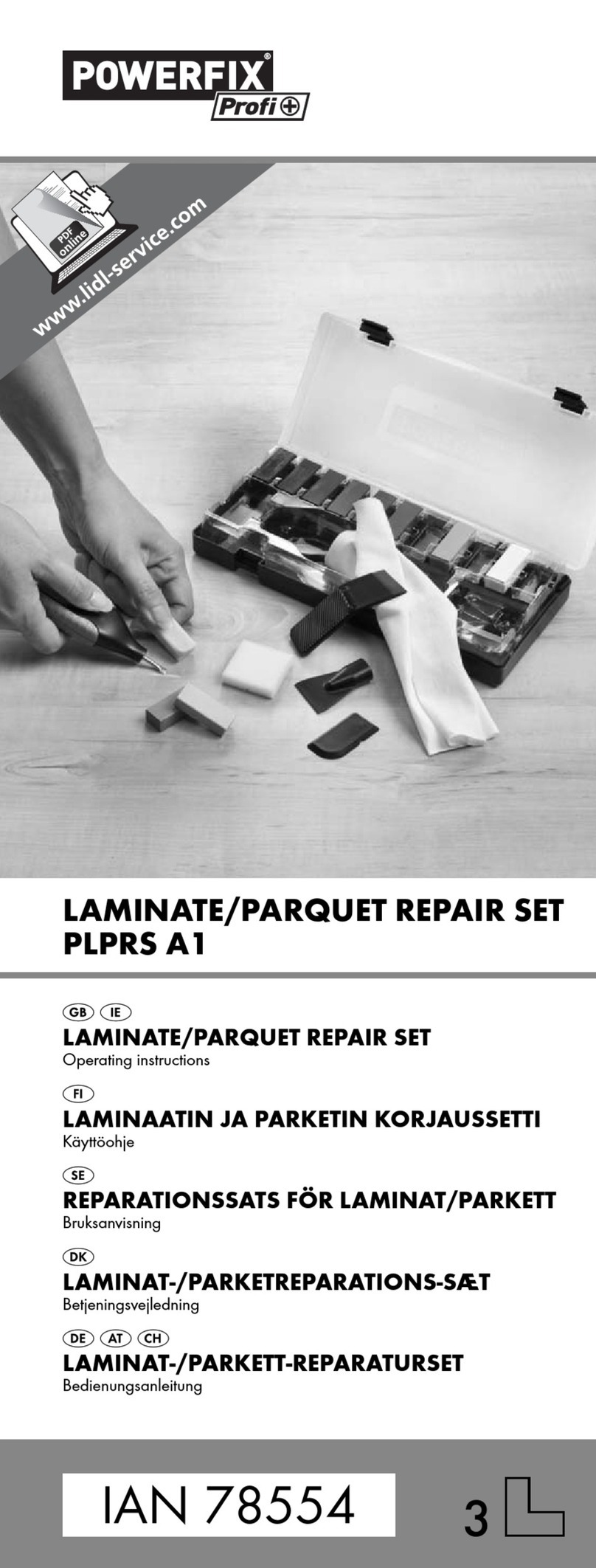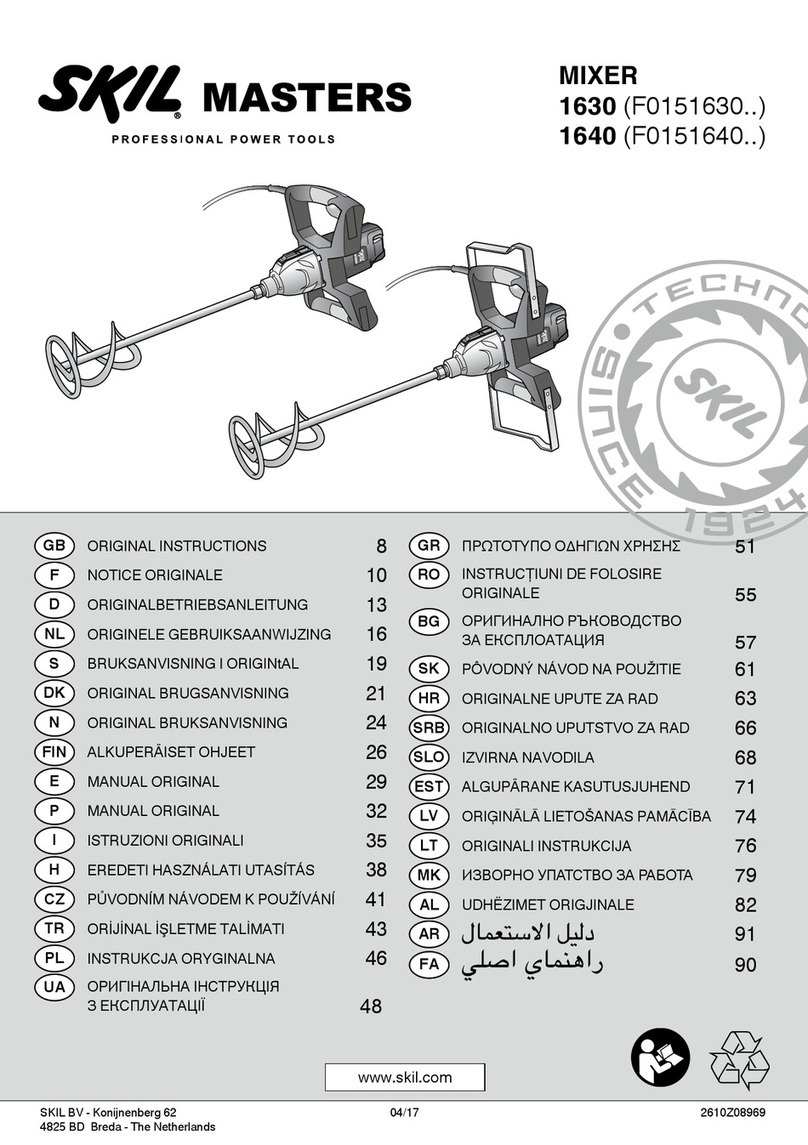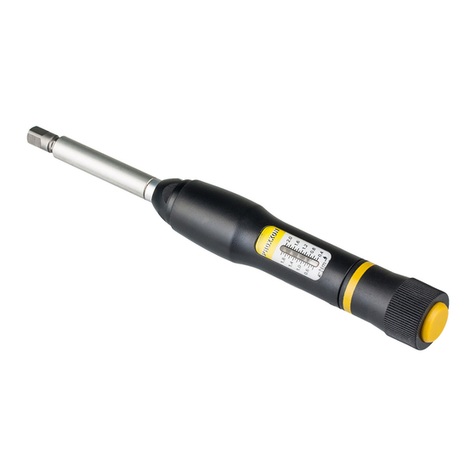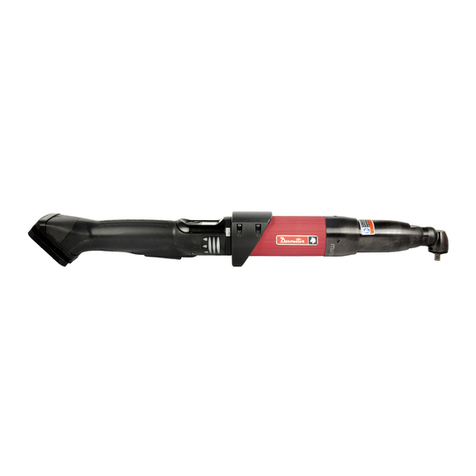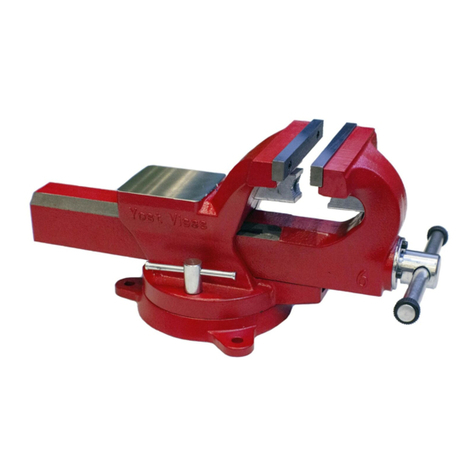Rockwell Automation Allen-Bradley 1756-L61S User manual

Safety Accelerator Toolkit
Catalog Numbers 1756-L61S, 1756-L62S, 1756-L63S, 1756-LSP, 1756-L71S, 1756-L72S, 1756-L73S, 1756-L7SP, 1756-L73SXT, 1756-L7SPXT,
1768-L43S, 1768-L45S, 1756-L72EROMS, 1769-L30ERMS, 1769-L33ERMS, 1769-L36ERMS
Quick Start
Original Instructions

Important User Information
Read this document and the documents listed in the additional resources section about installation, configuration, and
operation of this equipment before you install, configure, operate, or maintain this product. Users are required to
familiarize themselves with installation and wiring instructions in addition to requirements of all applicable codes, laws,
and standards.
Activities including installation, adjustments, putting into service, use, assembly, disassembly, and maintenance are
required to be carried out by suitably trained personnel in accordance with applicable code of practice.
If this equipment is used in a manner not specified by the manufacturer, the protection provided by the equipment may
be impaired.
In no event will Rockwell Automation, Inc. be responsible or liable for indirect or consequential damages resulting from
the use or application of this equipment.
The examples and diagrams in this manual are included solely for illustrative purposes. Because of the many variables and
requirements associated with any particular installation, Rockwell Automation, Inc. cannot assume responsibility or
liability for actual use based on the examples and diagrams.
No patent liability is assumed by Rockwell Automation, Inc. with respect to use of information, circuits, equipment, or
software described in this manual.
Reproduction of the contents of this manual, in whole or in part, without written permission of Rockwell Automation,
Inc., is prohibited.
Throughout this manual, when necessary, we use notes to make you aware of safety considerations.
Labels may also be on or inside the equipment to provide specific precautions.
WARNING: Identifies information about practices or circumstances that can cause an explosion in a hazardous
environment, which may lead to personal injury or death, property damage, or economic loss.
ATTENTION: Identifies information about practices or circumstances that can lead to personal injury or death, property
damage, or economic loss. Attentions help you identify a hazard, avoid a hazard, and recognize the consequence.
IMPORTANT Identifies information that is critical for successful application and understanding of the product.
SHOCK HAZARD: Labels may be on or inside the equipment, for example, a drive or motor, to alert people that dangerous
voltage may be present.
BURN HAZARD: Labels may be on or inside the equipment, for example, a drive or motor, to alert people that surfaces may
reach dangerous temperatures.
ARC FLASH HAZARD: Labels may be on or inside the equipment, for example, a motor control center, to alert people to
potential Arc Flash. Arc Flash will cause severe injury or death. Wear proper Personal Protective Equipment (PPE). Follow ALL
Regulatory requirements for safe work practices and for Personal Protective Equipment (PPE).

Rockwell Automation Publication IASIMP-QS005H-EN-P - April 2016 3
Table of Contents
Summary of Changes . . . . . . . . . . . . . . . . . . . . . . . . . . . . . . . . . . . . . . . . . . . . . . . . . . . . . . . . . . . . . . . 7
Where to Start . . . . . . . . . . . . . . . . . . . . . . . . . . . . . . . . . . . . . . . . . . . . . . . . . . . . . . . . . . . . . . . 9
Preface About This Publication. . . . . . . . . . . . . . . . . . . . . . . . . . . . . . . . . . . . . . . . 11
Software Requirements . . . . . . . . . . . . . . . . . . . . . . . . . . . . . . . . . . . . . . . . 11
Additional Resources . . . . . . . . . . . . . . . . . . . . . . . . . . . . . . . . . . . . . . . . . . 12
Chapter 1
Risk Assessment and System
Design
Introduction. . . . . . . . . . . . . . . . . . . . . . . . . . . . . . . . . . . . . . . . . . . . . . . . . . 13
Before You Begin. . . . . . . . . . . . . . . . . . . . . . . . . . . . . . . . . . . . . . . . . . . . . . 13
Follow These Steps . . . . . . . . . . . . . . . . . . . . . . . . . . . . . . . . . . . . . . . . . . . . 14
Safety Strategy Fundamentals . . . . . . . . . . . . . . . . . . . . . . . . . . . . . . . . . . 14
Conducting a Team-based Risk Assessment . . . . . . . . . . . . . . . . . . . . . 16
Task and Hazard Identification. . . . . . . . . . . . . . . . . . . . . . . . . . . . . 16
Risk Estimation . . . . . . . . . . . . . . . . . . . . . . . . . . . . . . . . . . . . . . . . . . . 16
Risk Assessment Example for Robot Cell Application . . . . . . . . 18
Select Mitigation Techniques for Hazard Control . . . . . . . . . . . . . . . 22
Incorporate Protective Systems and Measures. . . . . . . . . . . . . . . . . . . . 22
Safety Specification Example for Robot Cell Application . . . . . . . . . 23
Load Station #1 . . . . . . . . . . . . . . . . . . . . . . . . . . . . . . . . . . . . . . . . . . . 23
Panel Assembly Feed Conveyor (B) . . . . . . . . . . . . . . . . . . . . . . . . . 24
How Rockwell Automation Can Help . . . . . . . . . . . . . . . . . . . . . . . . . . 25
Chapter 2
Hardware Selection and Safety
Wiring Layout
Introduction. . . . . . . . . . . . . . . . . . . . . . . . . . . . . . . . . . . . . . . . . . . . . . . . . . 27
Before You Begin. . . . . . . . . . . . . . . . . . . . . . . . . . . . . . . . . . . . . . . . . . . . . . 27
What You Need. . . . . . . . . . . . . . . . . . . . . . . . . . . . . . . . . . . . . . . . . . . . . . . 27
Follow These Steps . . . . . . . . . . . . . . . . . . . . . . . . . . . . . . . . . . . . . . . . . . . . 28
Select Hardware. . . . . . . . . . . . . . . . . . . . . . . . . . . . . . . . . . . . . . . . . . . . . . . 28
Defining Module and Safety Zone Tags . . . . . . . . . . . . . . . . . . . . . . . . . 30
Fill Out the Safety Zone Configuration Worksheet. . . . . . . . . . . 30
Fill Out the Safety Module Configuration Worksheet . . . . . . . . 32
Lay Out Your Safety Wiring . . . . . . . . . . . . . . . . . . . . . . . . . . . . . . . . . . . 36
Access and Gather Drawings from Toolkit. . . . . . . . . . . . . . . . . . . 36
Edit Project Drawing Set . . . . . . . . . . . . . . . . . . . . . . . . . . . . . . . . . . . 38
Considerations for Safety Drawings . . . . . . . . . . . . . . . . . . . . . . . . . 44
Access Other Allen-Bradley® CAD Drawings . . . . . . . . . . . . . . . . 45

4Rockwell Automation Publication IASIMP-QS005H-EN-P - April 2016
Table of Contents
Chapter 3
GuardLogix® Controllers Logic
Integration
Introduction. . . . . . . . . . . . . . . . . . . . . . . . . . . . . . . . . . . . . . . . . . . . . . . . . . 47
Before You Begin. . . . . . . . . . . . . . . . . . . . . . . . . . . . . . . . . . . . . . . . . . . . . . 47
What You Need. . . . . . . . . . . . . . . . . . . . . . . . . . . . . . . . . . . . . . . . . . . . . . . 47
Follow These Steps . . . . . . . . . . . . . . . . . . . . . . . . . . . . . . . . . . . . . . . . . . . . 48
Open the GuardLogix Application File. . . . . . . . . . . . . . . . . . . . . . . . . . 49
Configure Your Guard I/O Modules. . . . . . . . . . . . . . . . . . . . . . . . . . . . 51
Create Your Safety Logic Routines. . . . . . . . . . . . . . . . . . . . . . . . . . . . . . 56
Import Your Safety Input Device Logic . . . . . . . . . . . . . . . . . . . . . . . . . 56
Import Your Safety Output Device Logic . . . . . . . . . . . . . . . . . . . . . . . 62
Add Safety Input and Safety Output Device Logic for
Each Safety Zone. . . . . . . . . . . . . . . . . . . . . . . . . . . . . . . . . . . . . . . . . . . . . . 67
Adding Your Faceplate Logic. . . . . . . . . . . . . . . . . . . . . . . . . . . . . . . . . . . 67
Faceplate Logic for Safety Instruction Faceplates . . . . . . . . . . . . . . . . . 68
Import User-defined Data Type for Safety Instruction
Faceplates. . . . . . . . . . . . . . . . . . . . . . . . . . . . . . . . . . . . . . . . . . . . . . . . . 68
Create Faceplate Animation Tags for Safety Instruction
Faceplates. . . . . . . . . . . . . . . . . . . . . . . . . . . . . . . . . . . . . . . . . . . . . . . . . 69
Faceplate Logic for Digital Guard I/O Faceplates . . . . . . . . . . . . . . . . 70
Import Add-On Instruction for Digital Guard I/O Faceplate . 70
Create Controller Tags for Digital Guard I/O Faceplate . . . . . . 71
Create GuardIO_AOI Instances in Standard Program Routines
for Each Digital Guard I/O Faceplate . . . . . . . . . . . . . . . . . . . . . . . 73
Configure Guard I/O Module Add-On Instruction Message
Instructions for each Digital Guard I/O Faceplate. . . . . . . . . . . . 78
Faceplate Logic for Analog Guard I/O Faceplates . . . . . . . . . . . . . . . . 82
Import Add-On Instructions for Analog Guard I/O
Faceplates. . . . . . . . . . . . . . . . . . . . . . . . . . . . . . . . . . . . . . . . . . . . . . . . . 82
Create a GuardIO_Analog_AOI Instance in a Standard
Program Routine . . . . . . . . . . . . . . . . . . . . . . . . . . . . . . . . . . . . . . . . . . 84
Create a GuardIO_Analog_AOI_Safety Instance in a Safety
Program Routine . . . . . . . . . . . . . . . . . . . . . . . . . . . . . . . . . . . . . . . . . . 85
Map Standard Tachometer Reset Tags to Safety Reset Tags . . . 89
Map Digital and Analog GuardIO_AOI Tags to Safety Zone
Reset Tags . . . . . . . . . . . . . . . . . . . . . . . . . . . . . . . . . . . . . . . . . . . . . . . . . . . . 94
Configure Logix Communication . . . . . . . . . . . . . . . . . . . . . . . . . . . . . . 98
Save and Download Your Program . . . . . . . . . . . . . . . . . . . . . . . . . . . . 100
Chapter 4
SmartGuard™ 600 Controllers
Logic Integration
Introduction. . . . . . . . . . . . . . . . . . . . . . . . . . . . . . . . . . . . . . . . . . . . . . . . . 101
Before You Begin. . . . . . . . . . . . . . . . . . . . . . . . . . . . . . . . . . . . . . . . . . . . . 101
What You Need. . . . . . . . . . . . . . . . . . . . . . . . . . . . . . . . . . . . . . . . . . . . . . 101
Follow These Steps . . . . . . . . . . . . . . . . . . . . . . . . . . . . . . . . . . . . . . . . . . . 102

Rockwell Automation Publication IASIMP-QS005H-EN-P - April 2016 5
Table of Contents
Configure Your SmartGuard 600 Controller and Safety I/O. . . . . 102
Select and Save Pre-configured Configuration File. . . . . . . . . . . 102
Delete, Add, and Configure SmartGuard 600 Controller and
Guard I/O Modules . . . . . . . . . . . . . . . . . . . . . . . . . . . . . . . . . . . . . . 104
Configure SmartGuard 600 Local Inputs and Test Outputs. . 108
Configure SmartGuard 600 Local Outputs . . . . . . . . . . . . . . . . . 113
Create Your Safety Zone Logic . . . . . . . . . . . . . . . . . . . . . . . . . . . . . . . . 116
Select Zone Inputs. . . . . . . . . . . . . . . . . . . . . . . . . . . . . . . . . . . . . . . . 117
Select Safety Device Function Blocks and Connect Inputs . . . 120
Select Input Logic Function Blocks and Connect Inputs . . . . . 122
Import Zone Function Block and Connect Inputs. . . . . . . . . . . 122
Select Zone Outputs and Connect to Zone Function Block . . 125
Save and Download Your RSNetWorx Project . . . . . . . . . . . . . . . . . 127
Verify Zone Safety Logic Operation. . . . . . . . . . . . . . . . . . . . . . . . . . . . 130
Add Your Faceplate Logic. . . . . . . . . . . . . . . . . . . . . . . . . . . . . . . . . . . . . 130
Copy SmartGuard 600 Module Configuration to Your Logix
Controller Project . . . . . . . . . . . . . . . . . . . . . . . . . . . . . . . . . . . . . . . . 130
Import SmartGuard 600 Faceplate Add-On Instruction and
Logic Rungs to Your Logix Controller Project . . . . . . . . . . . . . . 132
Create an Instance of Your SmartGuard 600 Faceplate Add-On
Instruction in Your CompactLogix Project Routine . . . . . . . . . 137
Configure CompactLogix Communication. . . . . . . . . . . . . . . . . . . . . 141
Save and Download Your Program . . . . . . . . . . . . . . . . . . . . . . . . . . . . 142
Chapter 5
FactoryTalk® View ME Software
Integration
Introduction. . . . . . . . . . . . . . . . . . . . . . . . . . . . . . . . . . . . . . . . . . . . . . . . . 143
Before You Begin. . . . . . . . . . . . . . . . . . . . . . . . . . . . . . . . . . . . . . . . . . . . . 144
What You Need. . . . . . . . . . . . . . . . . . . . . . . . . . . . . . . . . . . . . . . . . . . . . . 144
Follow These Steps . . . . . . . . . . . . . . . . . . . . . . . . . . . . . . . . . . . . . . . . . . . 144
Configure Your Safety Instruction Faceplates. . . . . . . . . . . . . . . . . . . 145
Configure Your Guard I/O or SmartGuard 600 I/O Faceplates . . 148
Adding Pre-configured Goto Buttons to Your FactoryTalk View
ME Application. . . . . . . . . . . . . . . . . . . . . . . . . . . . . . . . . . . . . . . . . . . . . . 151
Add Goto Buttons to Your Application . . . . . . . . . . . . . . . . . . . . 151
Associate Each Button to a Faceplate and Parameter File. . . . . 154
Create a Runtime File . . . . . . . . . . . . . . . . . . . . . . . . . . . . . . . . . . . . . . . . 159
Chapter 6
Safety System Application Guide Introduction. . . . . . . . . . . . . . . . . . . . . . . . . . . . . . . . . . . . . . . . . . . . . . . . . 161
Before You Begin. . . . . . . . . . . . . . . . . . . . . . . . . . . . . . . . . . . . . . . . . . . . . 161
What You Need. . . . . . . . . . . . . . . . . . . . . . . . . . . . . . . . . . . . . . . . . . . . . . 161
Follow These Steps . . . . . . . . . . . . . . . . . . . . . . . . . . . . . . . . . . . . . . . . . . . 162
Launching Your Faceplates from Your System Overview Display . 163
Safety System Overview Display . . . . . . . . . . . . . . . . . . . . . . . . . . . . . . . 163
Digital Guard I/O Module Faceplate Overview . . . . . . . . . . . . . . . . . 164

6Rockwell Automation Publication IASIMP-QS005H-EN-P - April 2016
Table of Contents
Digital Guard I/O Module Faceplate Input Status View –
Demand Indication . . . . . . . . . . . . . . . . . . . . . . . . . . . . . . . . . . . . . . . . . . 164
Digital Guard I/O Module Faceplate Input Status View –
Fault Indication. . . . . . . . . . . . . . . . . . . . . . . . . . . . . . . . . . . . . . . . . . . . . . 165
Error Content, Probable Cause, and Recommended Actions . 166
Digital Guard I/O Module Faceplate Output Status View . . . . . . . 167
Digital Guard I/O Module Faceplate – Online Configuration
Options . . . . . . . . . . . . . . . . . . . . . . . . . . . . . . . . . . . . . . . . . . . . . . . . . . . . . 168
Digital Guard I/O Module Faceplate – Online Help Options. . . . 169
Analog Guard I/O Faceplate Overview. . . . . . . . . . . . . . . . . . . . . . . . . 169
Analog Guard I/O Module Faceplate Input Status View –
Fault Indication. . . . . . . . . . . . . . . . . . . . . . . . . . . . . . . . . . . . . . . . . . . . . . 170
Error Content, Probable Cause, and Recommended Actions . 171
Analog Guard I/O Module Faceplate – Online Configuration
Options . . . . . . . . . . . . . . . . . . . . . . . . . . . . . . . . . . . . . . . . . . . . . . . . . . . . . 173
Analog Guard I/O Module Faceplate – Online Help Options . . . 174
Safety Instruction Faceplate Overview . . . . . . . . . . . . . . . . . . . . . . . . . 174
Safety Instruction Faceplate – Fault Views. . . . . . . . . . . . . . . . . . . . . . 175
Safety Instruction Faceplate – Diagnostic Views . . . . . . . . . . . . . . . . 175
Appendix A
Robot Cell Application Example
with GuardLogix® or
SmartGuard™ 600 Controller
Introduction. . . . . . . . . . . . . . . . . . . . . . . . . . . . . . . . . . . . . . . . . . . . . . . . . 177
Robot Cell Module and Safety Zone Configuration . . . . . . . . . . . . . 178
Robot Cell Safety Logic Examples . . . . . . . . . . . . . . . . . . . . . . . . . . . . . 182
Robot Cell Faceplate Logic Examples . . . . . . . . . . . . . . . . . . . . . . . . . . 188
Appendix B
Safety Output Logic Example for
Multiple Output Devices
. . . . . . . . . . . . . . . . . . . . . . . . . . . . . . . . . . . . . . . . . . . . . . . . . . . . . . . . . . . . . 191
Appendix C
GuardLogix® Tools GuardLogix Safety Calculator . . . . . . . . . . . . . . . . . . . . . . . . . . . . . . . . . 193
GuardLogix Estimator . . . . . . . . . . . . . . . . . . . . . . . . . . . . . . . . . . . . . . . . 194
No-fault Reaction Time (ms) . . . . . . . . . . . . . . . . . . . . . . . . . . . . . . 196
Single-fault Reaction Time (ms) . . . . . . . . . . . . . . . . . . . . . . . . . . . 197
Multiple-fault Reaction Time (ms). . . . . . . . . . . . . . . . . . . . . . . . . 197
Which Reaction Time to Use?. . . . . . . . . . . . . . . . . . . . . . . . . . . . . 197
Safety Estimator Installation Information . . . . . . . . . . . . . . . . . . . . . . 197
Macro Security in Microsoft Excel 2007 . . . . . . . . . . . . . . . . . . . . 198
Microsoft Excel 2003 . . . . . . . . . . . . . . . . . . . . . . . . . . . . . . . . . . . . . 198
Using Other Versions of Microsoft Excel Software . . . . . . . . . . 198

Rockwell Automation Publication IASIMP-QS005H-EN-P - April 2016 7
Summary of Changes
This manual contains new and updated information as indicated in this table.
.
Topic Page
Revised available catalog numbers. Front cover
Added LogixDesigner row to Software Requirements table. 11
Added publication 1769-UM022 to the Additional Resources table. 12
Revised title to publication 1756-RM099 in Additional Resources table. 12
Added Compact GuardLogix® 5370 information row to Table 6. 29
Revised instructions and graphics in Access Other Allen-Bradley® CAD Drawings section. 45
Added LogixDesigner software version information to What You Need section. 47
Updated website URL for Safety Accelerator Toolkit in What You Need section. 47
Added publication 1769-UM022 to What You Need section. 47
Revised information and graphic in third bullet point. 53
Added information to step 14. 55
Revised information in step 6 and added step 7. 74
Revised information in step 12. 81
Revised information in step 6 and added step 7. 85
Added Compact GuardLogix 5370 controller to What You Need section. 161

8Rockwell Automation Publication IASIMP-QS005H-EN-P - April 2016
Summary of Changes
Notes:

Rockwell Automation Publication IASIMP-QS005H-EN-P - April 2016 9
Where to Start
Follow this path to complete your safety application.
Chapter 1
Risk Assessment and System Design
Chapter 2
Hardware Selection and Safety Wiring Layout
Chapter 3
GuardLogix® Controllers Logic Integration
Chapter 5
FactoryTalk® View ME Software Integration
Chapter 6
Safety System Application Guide
Chapter 4
SmartGuard™ 600 Controllers Logic Integration

10 Rockwell Automation Publication IASIMP-QS005H-EN-P - April 2016
Where to Start
Notes:

Rockwell Automation Publication IASIMP-QS005H-EN-P - April 2016 11
Preface
About This Publication
This quick start provides a framework to develop safety applications. Each section guides you through the tasks that you
need to perform to design, program, and monitor your safety application.
To assist in the design and installation of your system, application files and other information are provided on the Safety
Accelerator Toolkit, SAFETY-CL002. The DVD provides CAD drawings for components, wiring diagrams, logic
routines, and more. With these tools and the built-in best-practices design, you can focus on the design of your system
and not on design overhead tasks.
Each chapter begins with the following information. Read these sections carefully before you begin work in each chapter.
•Before You Begin - This section lists the steps that must be completed and decisions that must be made before you
start that chapter. The chapters in this quick start do not have to be completed in the order in which they appear,
but this section defines the minimum amount of preparation required before you complete the current chapter.
•What You Need - This section lists the tools that are required to complete the steps in the current chapter. This
includes, but is not limited to, hardware and software.
•Follow These Steps - This illustrates the steps in the current chapter and identifies which steps are required to
complete the examples.
Software Requirements
You need these software to use this toolkit.
IMPORTANT Before you use this quick start and the CD, read the Terms and Conditions on the CD.
Rockwell Automation® Software Version
RSLogix 5000® 16 or later for 1756 GuardLogix® controllers
18 or later for 1768 GuardLogix controllers
Studio 5000® environment 28.00.00 or later for 5370 Compact GuardLogix controllers
FactoryTalk® View Machine Edition 6.1 or later
RSNetWorx™ for DeviceNet 9.1 or later for 1752-L24BBBE SmartGuard™ 600 controller
RSLinx® Classic 2.55 or later for 1756 and 1768 GuardLogix controllers
3.80 or later for 5370 Compact GuardLogix controllers

12 Rockwell Automation Publication IASIMP-QS005H-EN-P - April 2016
Preface
Additional Resources
These documents contain additional information concerning related products from Rockwell Automation.
You can view or download publications at http://www.rockwellautomation.com/literature. To order paper copies of
technical documentation, contact your local Allen-Bradley® distributor or Rockwell Automation sales representative.
Resource Description
GuardLogix Controllers User Manual, publication 1756-UM020
Provides information to configure and program the 1756 GuardLogix system in RSLogix 5000 software.
GuardLogix 5570 Controllers User Manual, publication 1756-UM022
Provides information to configure and program the 1756 GuardLogix system in the Studio 5000 environment.
Compact GuardLogix Controllers User Manual, publication 1768-UM002 Provides information to configure and program the 1768 Compact GuardLogix controller system.
Compact GuardLogix 5370 Controllers User Manual, publication
1769-UM022
Provides information to configure and program the Compact GuardLogix 5370 controller system.
GuardLogix Controller Systems Safety Reference Manual, publication
1756-RM093
Contains detailed requirements to achieve and maintain SIL 3 with the GuardLogix controller system
and RSLogix 5000 software.
GuardLogix 5570 and Compact GuardLogix 5370 Controller Systems
Safety Reference Manual, publication 1756-RM099
Contains detailed requirements to achieve and maintain SIL 3 with the GuardLogix and Compact
GuardLogix controller systems, and the Studio 5000 environment.
SmartGuard 600 Controller Installation Instructions, publication1752-IN001
Provides information to install the SmartGuard 600 controller.
SmartGuard 600 Controllers User Manual, publication 1752-UM001 Provides information to configure and program the SmartGuard 600 controller system.
SmartGuard 600 Controllers Safety Reference Manual, publication
1752-RM001
Contains detailed requirements to achieve and maintain SIL 3 with the SmartGuard 600 controller system.
CompactBlock™ Guard I/O™ DeviceNet Safety Module Installation
Instructions, publication 1791DS-IN002
Provides information to install CompactBlock Guard I/O DeviceNet Safety modules.
Guard I/O DeviceNet Safety Modules User Manual, publication
1791DS-UM001
Provides information to use Guard I/O™ DeviceNet Safety modules.
Guard I/O EtherNet/IP Safety Modules Installation Instructions,
publication 1791ES-IN001
Provides information to install CompactBlock Guard I/O EtherNet/IP Safety modules.
Guard I/O EtherNet/IP Safety Modules User Manual, publication
1791ES-UM001
Provides information to use Guard I/O EtherNet/IP Safety modules.
POINT Guard I/O™ Safety Module User Manual, publication 1734-UM013 Provides information to install, configure, and operate POINT Guard I/O Safety Modules.
Safety Products Catalog available at http://www.ab.com/catalogs/ Provides selection and specification information for Rockwell Automation safety products.
CompactLogix™ System User Manual, publication 1769-UM007 Provides information to configure, operate, and troubleshoot systems with 1769-L20 or 1769-L30
CompactLogix controllers.
1769-L20, 1769-L30 CompactLogix Controllers Installation Instructions,
publication 1769-IN047
Provides information to install 1769-L20 or 1769-L30 CompactLogix controllers.
1769 CompactLogix Controllers User Manual, publication 1769-UM011 Provides information to configure, operate, and troubleshoot systems with 1769-L31, 1769-L32C,
1769-L32CR, 1769-L32E, or 1769-L35E CompactLogix controllers.
1769-L31 CompactLogix Controller Installation Instructions, publication
1769-IN069
Provides information to install 1769-L31 CompactLogix controllers.
1769-L32C, 1769-L32CR CompactLogix Controller Installation
Instructions, publication 1769-IN070
Provides information to install 1769-L32C and 1769-L32CR CompactLogix controllers.
CompactLogix Controller Installation Instructions, publication
1769-IN020
Provides information to install 1769-L32E and 1769-L35E CompactLogix controllers.
Logix Common Procedures Programming Manual, publication
1756-PM001
Provides information to program Logix5000 controllers, which includes how to manage project files,
organize tags, program and test routines, and handle faults.
Rockwell Automation Configuration and Selection Tools, available at
http://www.rockwellautomation.com/en/e-tools/
These online tools install on your personal computer so that you can quickly access information on our
products:
• CrossWorks™
• Industrial Computer Selector
• Operator Interface Selection Tool
• Programmable Controller Family Selector

Rockwell Automation Publication IASIMP-QS005H-EN-P - April 2016 13
Chapter 1
Risk Assessment and System Design
Introduction
The GuardLogix® controller offers you the capability to integrate safety and standard control in the same system. Safety
functions supported by the system include:
• Determine specifically which gate has been opened or E-stop device has been pressed
• Perimeter and point-of-operation guarding
•Zonecontrol
In this chapter, you learn the fundamentals of safety strategy development, see examples of risk assessment and estimation
worksheets and safety system design, and learn how Rockwell Automation can help.
In subsequent chapters of this toolkit, you’ll create a bill of materials based on the functional requirements identified by a
risk assessment. Once you’ve determined which safety components you’ll need, you’ll learn how to use the Safety
Accelerator Toolkit to layout your system wiring, integrate logic routines in your safety application program, and use
faceplates designed to facilitate HMI.
Before You Begin
Become familiar with the local, national, and international standards, including consensus standards that govern machine
safety.
The safety standards that would be applied for safeguarding a work cell, like the example shown in this quick start, are
extensive.
• National Standards • Risk Assessment Standards • Robotic Standards
• Safeguarding Application Standards • Controller Application Standards • Electrical System Design Standards
• Personal Protective Equipment Standards • Standards pertaining to Awareness Means • Energy Isolation Standards for Maintenance Tasks
• Energy Isolation Standards for Routine, Repetitive
And Routine Tasks
• Standards relating to validation and maintenance
associated with the verification of the system performance
on a regular basis

14 Rockwell Automation Publication IASIMP-QS005H-EN-P - April 2016
Chapter 1 Risk Assessment and System Design
Follow These Steps
Safety Strategy Fundamentals
To devise a proper safety strategy, these steps must be addressed.
1. Risk Assessment: based on a clear understanding of the machine limits and functions and the tasks that may be
required to be performed throughout its life.
2. Risk Reduction: performed if necessary with safety measures selected and implemented based on the
performance requirements dictated by the risk assessment methodology.
Risk Assessment Methodologies dictate that the hierarchy of safety controls be followed, implementing system
redesign measures, if possible, to totally eliminate the risk.
A hazard control technique must be defined for each hazardous motion, including each mode of operation (such
as Automatic, Jog, or Cycle Stop) and each demand on the safety system (such as E-stop device activated or safety
gate opened). This is essential so that the energy source is properly controlled in all interactions with the machine
and all demand scenarios on the safety system.
Start
Safety Strategy Fundamentals, page 14
Conducting a Team-based Risk Assessment,
page 16
Select Mitigation Techniques for Hazard
Control, page 22
Incorporate Protective Systems and
Measures, page 22
Safety Specification Example for Robot Cell
Application, page 23
How Rockwell Automation Can Help,
page 25
IMPORTANT The information in this section is not advocated as the definitive method. Individual circumstances may dictate a different
approach. It is intended as a general guideline to encourage a methodical and documented structure.

Rockwell Automation Publication IASIMP-QS005H-EN-P - April 2016 15
Risk Assessment and System Design Chapter1
The manner in which risk assessment and risk reduction are performed is the basis of the safety strategy for the machine.
3. Functional Safety Specification: performed to identify the required functionality of the total system. The
functional safety specification includes identification of:
• the interconnections between standard control and the safety control system.
• all of the safety devices (input, output, and logic-solving).
• the requirements for integrating devices into the existing system.
• the sequence of events due to various demands on the safety system for each mode of machine operation.
• diagnostic requirement.
• any other items related to the system design.
4. Design, building, and installation of the system.
5. Final Risk Assessment: conducted to make sure that no new hazards have been introduced into the system.
6. Administrative Requirements and Training: develop and implement administrative requirements, as well as
operator, technician, and affected personnel training.
7. Va l id ati on : performed prior to production release to verify that the safety system meets the requirements set forth
by the risk assessment and performs at the proper level of fault tolerance prescribed by the chosen methodology.
Identify all machines within the
workplace—Then for each machine
Consult relevant
information and
expertise
MACHINE LIMITS
Can you foresee all possible
operation and use of the machine
HAZARD IDENTIFICATION
Identify each hazard situation—
Then for each hazard
YES
NO
RISK ESTIMATION
Estimate the level of risk due
to the hazard
RISK EVALUATION
Is the level of risk
acceptable
Address the hazard by a
process of re-design or
additional measures
Determine whether the
performance and functional
characteristics of the safety
measure are suitable for the
machine and its type of use
RISK ASSESSMENT
RISK REDUCTION
Have any safety measures
been analyzed and
proven adequate?
END OF
PROCESS SAFETY STRATEGY
YES
NO
NO

16 Rockwell Automation Publication IASIMP-QS005H-EN-P - April 2016
Chapter 1 Risk Assessment and System Design
Conducting a Team-based Risk Assessment
A formal team-based risk assessment is a task-by-task evaluation of the hazards that operators, technicians, and other
personnel may come in contact with. The results of a risk assessment help designers identify a more complete list of
hazards that can be addressed and mitigated by following a formal process.
The formal process embraces a hierarchy of measures for risk reduction that includes system redesign, engineered
guarding, administrative and training requirements, awareness means, and personal protective equipment (PPE)
identification. This leads to a systematic approach to reducing risk, not a guarding bandage approach.
Risk assessments include a risk rating system for identifying the risk level for each task and hazard combination. Once the
hazards are understood, mitigation techniques are applied to lower the risk to an acceptable level. A system designer who
uses a formal risk assessment methodology, based on safety standards, shows due diligence in the safety system design.
Some formal processes and standards also provide steps to identify the residual risk after the mitigation techniques have
been applied and provide guidelines on what is an acceptable level of residual risk.
Overall, the risk assessment process establishes the appropriate level of safety guarding, so that you don’t over- or under-
design but apply the right level of risk mitigation to the hazard.
Task and Hazard Identification
All of the hazards at the machine must be identified and listed in terms of their nature and location. Examples of hazards
include crushing, shearing, entanglement, part ejections, fumes, radiation, heat, noise, and more.
For each hazard, be sure to identify the energy source and component that could cause the injury, such as a crushed arm
due to powered robot motion or a crushed hand due to uncontrolled vertical motion from the potential energy of a
gantry.
The results of a task analysis should be compared with the results of hazard identification to show where there are
possibilities for the convergence of a hazard and a hazardous situation.
Risk Estimation
Any machine that has the potential for hazardous situations presents a risk of a hazardous event, that is, causing physical
harm, property or environmental damage. The greater the risk, the more important it becomes to do something about it.
To make a decision on how to respond to the risk, you need to be able to quantify it.
Risk is often thought of solely in terms of the severity of injury at an accident. Both the severity of potential harm and the
probability of its occurrence have to be taken into account to estimate the amount of risk present. Probability of
occurrence comprises two factors: the frequency of exposure and the possibility of avoidance. Risk estimation assigns
values to each of these factors, which are then used to determine appropriate risk reduction measures that are feasible,
realistic, and cost-effective.
ISO 13849-1 provides methods and guidance on how to specify a safety-related control system that is providing a
protective measure or safety function.

Rockwell Automation Publication IASIMP-QS005H-EN-P - April 2016 17
Risk Assessment and System Design Chapter1
These two risk estimation flow charts are typical methods of defining risk for machinery safety. Other methods are
available for process safety. In fact, many of these types of tools are available. It's important to use these types of processes
to help define the level of risk.
Figure 1 - Risk Graph for Performance Level for a Safety Function (ISO 13849-1:2006
)
Figure 2 - Risk Graph for ISO13849-1:2006 Category Determination
Must be determined for each safety function!
S = Severity
F = Frequency or Duration of Exposure
P = Avoidance Probability
P2
P1
P2
P1
P2
P1
P2
P1
F2
F1
F2
F1
S2
S1
Low
High
b
a
c
d
e
Performance
Level, PLr
Contribution to
Risk Reduction
Start

18 Rockwell Automation Publication IASIMP-QS005H-EN-P - April 2016
Chapter 1 Risk Assessment and System Design
Risk Assessment Example for Robot Cell Application
The following is an example of a robot cell risk assessment worksheet including both task and hazard identification and
risk estimation.
Figure 3 - Line Name: XYZ Assembly and Inspection Station
This application consists of an assembly and inspection station with this equipment.
• Manual Loading Station #1 (A)
• Panel Assembly Feed Conveyor (B)
•6-axisServoRobot(C)
• Automated inspection station (D)
•OverheadTransferGantry(E)
• Finished Part Transfer Elevator (F)
B
Panel Assy.
Feed Conveyor
F
Parts Transfer
Elevator
Part Positioning Station #1 and #2
D
Inspection
Station
A
Load Station #1
C
Robot
E
Overhead Transfer Gantry

Rockwell Automation Publication IASIMP-QS005H-EN-P - April 2016 19
Risk Assessment and System Design Chapter1
The application follows this sequence of operation.
1. The Panel Assembly Feed Conveyor (B) indexes the panel into Panel Position Station #2.
2. The operator loads the part at Station #1 (A).
3. The operator initiates a part ready sequence to activate the robot.
4. Robot (C) picks part from Station #1 (A).
5. The robot inserts the part from Station #1 into a panel on the Panel Assembly Feed Conveyor.
6. The robot picks the assembly from Panel Assembly Feed Conveyor (B) and places it into the Inspection Station
(D).
7. The Overhead Transfer Gantry (E) transfers the assembly to the Transfer Elevator (F).
8. The Transfer Elevator (F) indexes one position to complete the cycle.
The machine operating modes, as defined by the operators, are Automatic, Manual, and Jog with gates open. The Jog
mode operation is required for the movement of the following equipment.
Equipment Movement
Robot (C) 5 axis
End of Arm (EOA) tooling
Overhead Transfer Gantry (E) X-axis
Y-axis
End of Arm (EOA) tooling
Parts Transfer Elevator (F) Index
Table 1 - Key for Risk Assessment Worksheet
Category Rating Description
S = Severity of injury S1 Slight (normally reversible)
S2 Serious (normally irreversible including death)
F = Frequency or exposure to hazard F1 Seldom to less often and/or the exposure time is short
F2 Frequent to continuous and/or the exposure time is long
P = Possibility of avoiding the hazard or limiting the harm P1 Possible under specific conditions
P2 Scarcely possible

20 Rockwell Automation Publication IASIMP-QS005H-EN-P - April 2016
Chapter 1 Risk Assessment and System Design
Table 2 - Risk Assessment Worksheet - Load Part at Load Station #1
Steps
Potential Incidents or
Accidents
Prior to Safeguards
Current Safeguards
Recommendations
With Safeguards
Severity of Injury
Frequency (Exposure)
Avoidance
Risk Reduction
Category(1)
Severity of Injury
Frequency (Exposure)
Avoidance
Residual Risk<Footnote>(1)
1. Remove part from
the transfer rack.
Ergonomic exposure due to part
pick location.
S2 F2 A2 R1 Evaluate cart design for pick elevation and
modify, if necessary.
S1 F2 A1 R3A
Train workers on proper lifting technique.
Job rotation.
Awareness posters on proper lifting technique.
Cuts to hands or arms due to
sharp edges on parts.
S2 F2 A2 R1 PPE: Hand and arm protection such as protective
gloves and sleeves.
S1 F1 A1 R4
Crushing or cuts due to cart tip-
over hazard.
S2 F1 A2 R2B Evaluate cart design for stability and correct if
required. Verify that the cart does not move
while unloaded.
S1 F1 A1 R4
2. Move part to
loading station on
stacklight
indication:
OK to load.
Slips or tripping due to debris
on the floor.
S2 F2 A1 R2A Enforce housekeeping procedures for floor
cleaning.
S2 F1 A1 R3B
Slips or tripping due to raised
edges or floor discontinuity.
S2 F2 A1 R2A Verify that the floor area does not have any
discontinuities higher than 3/16 in.
S2 F1 A1 R3B
3. Place part into
loadingfixture.Part
loading is complete
upon stacklight
indication: Part
position OK.
Mechanical impact: Pinch or
Crush hazard due to robot
motion.
S2 F2 A2 R1 Inhibit robot motion while person is in the
hazardous area.
a. Use hard guards to reduce hazardous area.
b. Use floor mat, light curtain, area scanner,
or automatic gate to sense when a person
is in the hazardous area or prevent
exposure to the hazardous area.
c. Implement robot zone control with
annunciation to allow for part loading
when robot does not present a hazard.
Use base safety limit switches to define
the zone.
d. Install a properly-rated safety control
system.
S1 F1 A1 R4
Eye injury due to compressed
air or airborne debris from the
environment.
S2 F1 A2 R2B PPE: Safety glasses to protect eyes. S1 F1 A1 R4
(1) Risk Ratings of R1, R2A, R2B, R3, R4 correspond to the Safety Control Circuit Performance requirements of ANSI/RIA R15.06-1999. An R1 rating represents a control reliable circuit with continuous
checking for electrical and fluid power circuits. See the standard for a complete definition of performance requirements for the related risk ratings.
This manual suits for next models
15
Table of contents
Popular Tools manuals by other brands
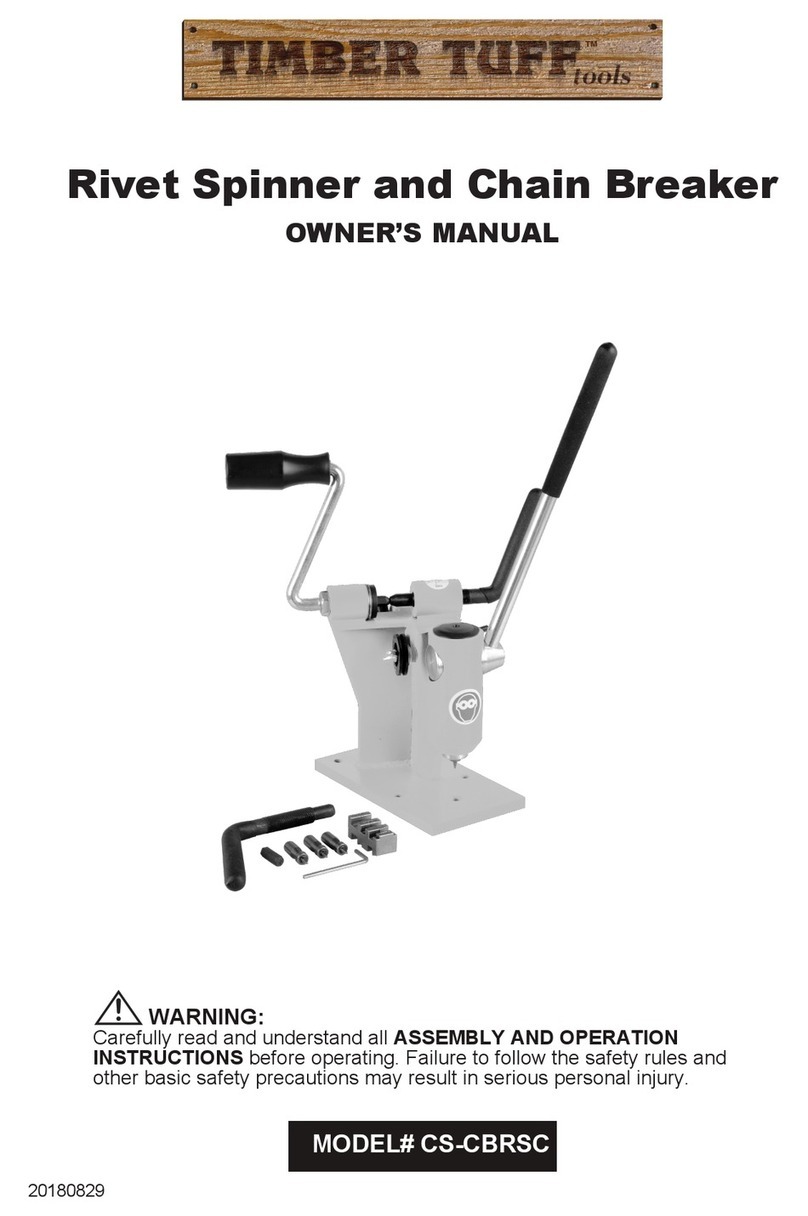
Timber Tuff Tools
Timber Tuff Tools CS-CBRSC owner's manual
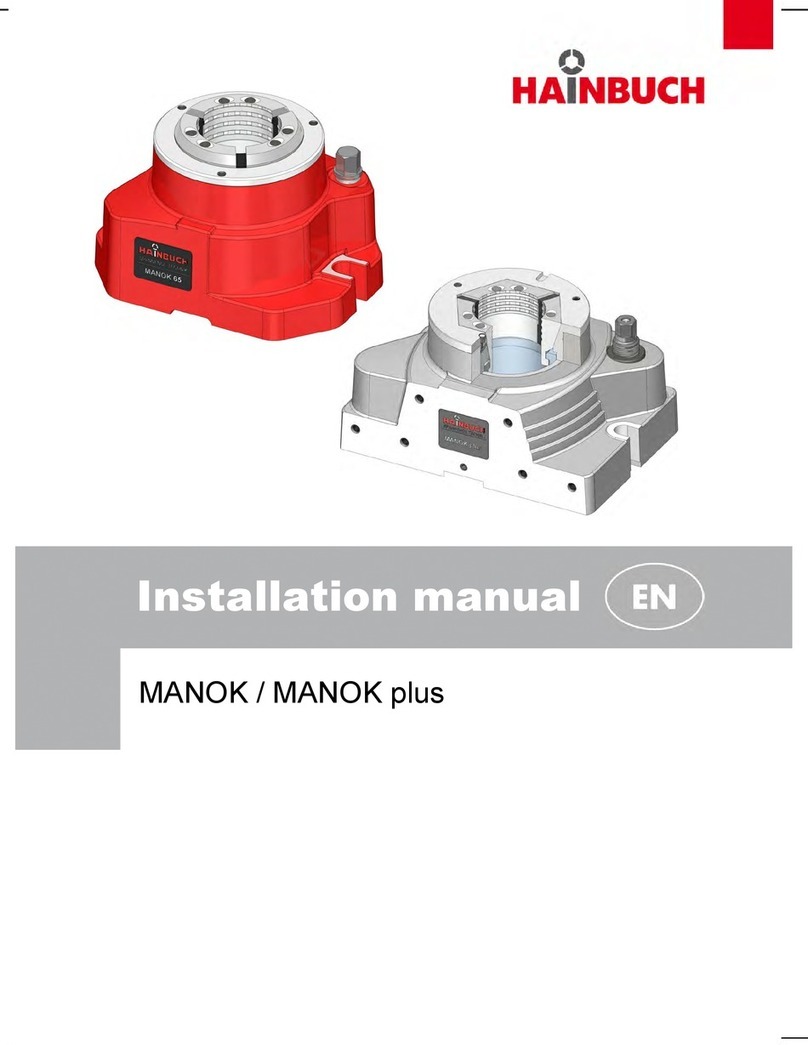
Hainbuch
Hainbuch MANOK installation manual
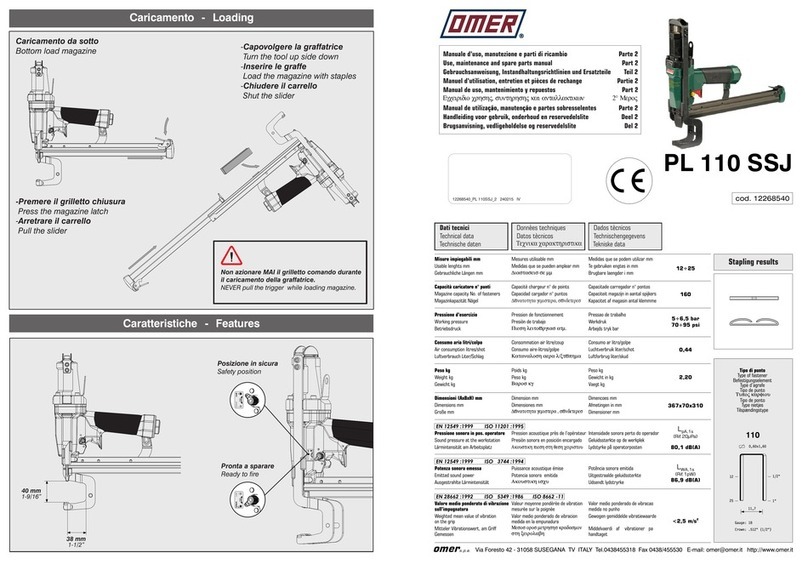
Omer
Omer PL 110 SSJ Use, maintenance and spare parts manual

Omega
Omega magiclift 29023 operating instructions

CALIMA
CALIMA 46060 operating instructions

Ingersoll-Rand
Ingersoll-Rand C225H Parts, operation and maintenance manual
